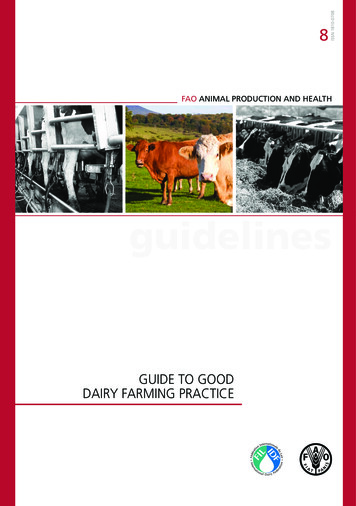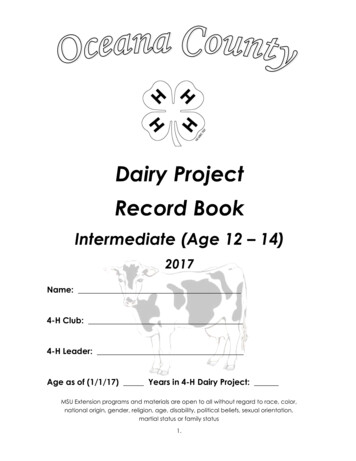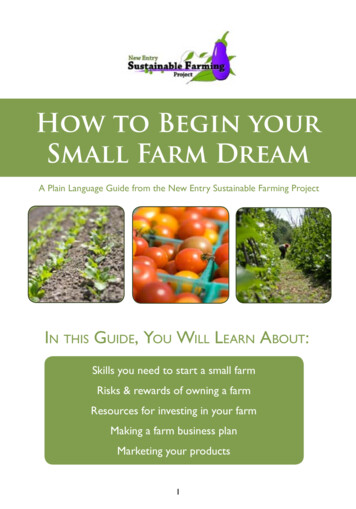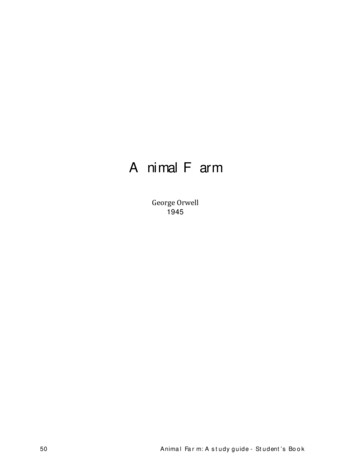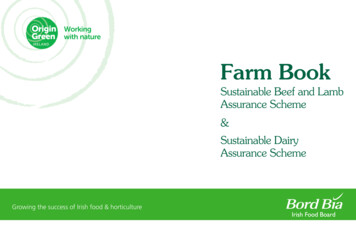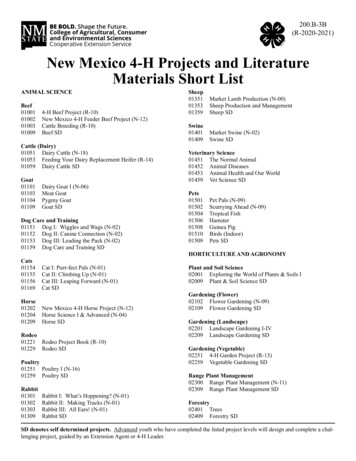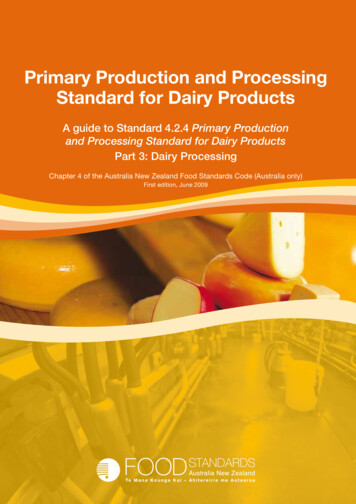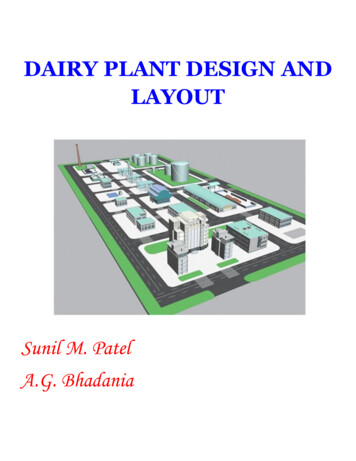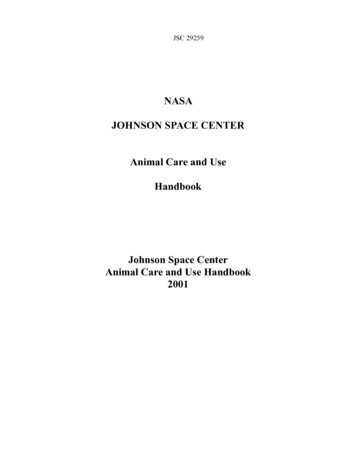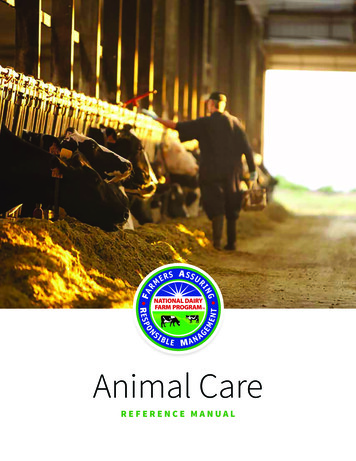
Transcription
TMAnimal CareREFERENCE MANUAL
TMThe 2017 National Dairy FARM (Farmers Assuring Responsible Management) Animal Care ReferenceManual is dedicated to Dr. Michael Johnson (1983 – 2016) in gratitude for his nearly three-yearservice to dairy farmers as an employee of Dairy Management, Inc. (DMI). Michael’s proactiveparticipation, astute observations and desire to inspire the dairy community to do better and bebetter were invaluable assets during the FARM Program revision process. Michael served as atrusted advisor and member of the FARM Program Technical Writing Group and on theNational Milk Producers Federation Animal Health and Wellbeing Committee.His significant contributions to this manual can be found in almost every chapter.Michael, we will miss your keen mind, dedication to the dairy community and friendship. 2016 National Milk Producers FederationThis manual is not a legal document and is intended for educational purposes only.Dairy farmers are individually responsible for determining and complying with all requirements oflocal, state and federal laws and regulations regarding animal care.
TA B LE OF CO N T E N TSChapter 1: Introduction The National Dairy FARMProgram and Consumer Trust Program Overview Acronyms Animal Care ReferenceManual Overview Management Checklists DefinitionsChapter 2: On-FarmSecond-Party Evaluations Continuous Improvement Plans Mandatory Corrective Action PlansChapter 3: ManagementProcedures Management Checklist Veterinarian-Client-PatientRelationship Employee Training Written Protocols Emergency Preparedness Identification andRecord Keeping Milking Routine Resources112233491010131314151516161719Chapter 4: Newborn andMilk-Fed Dairy Calves21Chapter 5: Nutrition27 Management ChecklistNutritionWaterMilk and Milk Replacer FeedingWeaningResources Management Checklist Water Feed Mycotoxins Specific Lifecycle NutritionalConsiderations ResourcesChapter 6: Animal Health Management Checklist Herd Health Plan Newborn and Milk-FedDairy Calves Painful Medical Procedures Animal Observations Hygiene Locomotion Body Condition Scoring (BCS) Hock and Knee Lesions Body Abrasions and Injuries Pest Control Specific Lifecycle Considerations 04141414243
Chapter 7: Environmentand Facilities Management ChecklistAnimal EnvironmentLying AreaSpecific Lifecycle ConsiderationsResources454546475255Chapter 8: Handling, Movementand Transportation57 Management Checklist Stockmanship Equipment Loading and Unloading Transportation Factors Newborn and Milk-Fed DairyCalf Handling Specific Lifecycle Considerations ResourcesChapter 9: Injured andNon-Ambulatory Animals Management Checklist Nutrition Animal Health Environment and Facilities Handling, Movement andTransportation Recommended Procedures forMoving a Non-Ambulatory Animal Resources57585859596060616363646466666769Chapter 10: Dairy Beef Management Checklist Dairy Beef Conditions that WarrantAdditional Testing at USDASlaughter Facilities Dairy Bull Calves andFreemartin Heifers ResourcesChapter 11: Third-PartyVerification Management Checklist Program Integrity ThroughThird-Party Verification Other Verification Options71717274747577777879References81Appendix91 A. Technical Writing GroupB. Hygiene ScoringC. Locomotion ScoringD. Body Condition ScoringE. Hock and Knee Lesion ScoringF. Safe HandlingG. Willful Mistreatment of AnimalsH. Top Considerations for CullingI. Practical Euthanasia of Cattle919399101111115119123125
01Introduction
The National Dairy FARM Program and Consumer TrustToday’s consumers expect – and deserve – safe,wholesome food from people who are producingit responsibly.U.S. dairy farmers have a strong track record ofproviding excellent animal care. The NationalDairy FARM Program: Farmers AssuringResponsible Management demonstratesdairy farmers’ ongoing commitment to thehighest standards and shows consumers thatthey’re doing what’s right for the cows, forcustomers – and for consumers who are morecurious than ever before about how their food israised and produced, but often are generationsremoved from the farm.In a recent study conducted by the AmericanHumane Association, 9 in 10 respondents(94.4 percent) indicated that they were “veryconcerned about farm animal welfare,” up from87 percent a year ago. More than three-quartersof respondents (75.7 percent) said they were verywilling to pay more for humanely raised eggs,meat and, most notably, dairy products. That’sup from 73 percent in 2013. And, according tothe same study, for the second year in a row,“humanely raised” scored highest among foodlabel importance, beating out “antibiotic-free,”“organic” and “natural.”Similarly, in a 2015 study conducted by TheCenter for Food Integrity, only 40 percent ofrespondents agreed with the statement: “Thefood system is on the right track.” Notably, 60percent of respondents strongly agreed withthe statement: “If farm animals were treatedhumanely, I would have no problem consumingmeat, milk and eggs.” However, only 25 percentstrongly agree that animals are treated humanelyon U.S. farms. More than half would support a lawin their state to ensure the humane treatmentof animals.Our customers and consumers give dairy farmersthe social license, or freedom, to determine howbest to raise their animals. In turn, the entiredairy industry needs to give them the permissionto trust that the best decisions are being madewhen it comes to caring for cows.The FARM Program, which began in 2009, helpsbuild and maintain that trust, demonstratingthat dairy farmers share consumer values and arecommitted to quality animal care and providingsafe, wholesome milk. The FARM Program givesthe public confidence that the dairy community isdoing the right things for the right reasons.Chapter 1Introduction1
Program OverviewCreated by the National Milk Producers Federation (NMPF), with support from Dairy Management,Inc. (DMI), the FARM Program raises the bar for the entire industry – creating a culture of continuousimprovement.Voluntary and available to all dairy farmers, the FARM Program establishes on-farm best managementpractices, on-farm Second-Party Evaluations and a system for Third-Party Verification that guarantees therigor and integrity of the program.Second-Party Evaluations and Third-Party Verification are critical elements of the FARM Program. TheSecond-Party Evaluation, completed on every participating dairy at least once every three years, providesdairy farms with an external review of their animal care practices based on FARM Program guidelines.Once the Second-Party Evaluation is complete the dairy farmer is eligible to be randomly selected,through statistical sampling, to undergo Third-Party Verification, which ensures the integrity of theprogram. The results are published each year in FARM’s Year in Review report.There are only two ways to be automatically removed from the FARM Program: (1) refusal to participatein Third-Party Verification, or (2) if willful mistreatment of animals is observed and the participating farmrefuses to complete all necessary actions under the FARM Willful Mistreatment of Animals protocol.The FARM Program Technical Writing Group, which includes representation from the veterinarycommunity, co-ops, processors, dairy organizations and university animal care faculty, guides theprogram – ensuring that it fosters a culture of continuous improvement and that the best managementpractices, which are the cornerstone of the program, evolve with the latest research on animal welfareand humane handling (see Appendix A).Additional information on the National Dairy FARM Program and program resources are availableonline at nationaldairyfarm.com.AABPACRONYMSADTAmerican Association of BovinePractitionersAnimal Disease TraceabilityNMPF National Milk Producers FederationSOPStandard Operating ProceduresAVMA American Veterinary MedicalAssociationTMRTotal Mixed RationBCSBody Condition ScoringUSDA United States Department ofAgricultureCIPContinuous Improvement PlanDMIDairy Management, Inc.HAACP Hazards Analysis and CriticalControl Points2MCAP Mandatory Corrective Action PlanAnimal Care Reference ORVeterinarian of Record
Animal Care Reference ManualFARM Program materials are living documents.Guidelines are reviewed every three years by theTechnical Writing Group and subject to updatesbased on new science-based animal care andwell-being research. This is part of the FARM Program’scommitment to continuous improvement.Along with the guidelines, this documentprovides extensive information, resourcesand references that while thorough, are notexhaustive, nor prescriptive for singularapproaches toward meeting the guidelinesof the program. This reference manual is nota legal or regulatory requirement for thedairy industry. It is intended to serve as awide-ranging educational resource for dairyfarmers across the United States.Management ChecklistsThis Animal Care Reference Manual is an easy-to-use,comprehensive resource detailing animal care andmanagement guidelines of the FARM Program.It’s an educational tool for all participating dairyfarmers, co-ops, proprietary processors, trainedSecond-Party Evaluators and Third-Party Verifiers.The Management Checklists detail key on-farmguidelines and best practices. ManagementChecklist points are listed at the beginning ofeach chapter and within the chapters undercorresponding topics.3Best practices identified in the manual are notthe only practices that can meet the identifiedguidelines. The application of some managementpractices may vary due to certain regional norms,weather or other conditions. Dairy farmers shouldwork with their veterinarians and other trainedprofessionals to develop appropriate managementapproaches to meet the identified guidelines.All chapters provide guidelines for these keyoverarching areas: nutrition, animal health,environment and facilities, and handling,movement and transportation. Specifically, ineach chapter you’ll find: Management Checklist(s)Description of best practicesSection for specific lifecycle considerationsList of resourcesDocumentation exists of trainingfor all (new and existing)employees with animal careresponsibilities for stockmanshipas well as their assigned animalcare responsibilities (such ascalf care, euthanasia, nonambulatory cow management,etc.) at least on an annual basis.Also listed in some chapters are FARM evaluationform informational questions.?Informational: Does the dairyhave copies on site and/or usethe FARM Program Milk andDairy Beef Drug ResiduePrevention Manual?Detailed explanations of Second-Party Evaluationsand Third-Party Verification are provided in Chapter2 and Chapter 11, respectively. A comprehensivelist of references for each chapter can be foundon page 81.Chapter 1Introduction3
D E F I N I TI O N SAnimal Welfare: How an animal is coping withthe conditions in which it lives. An animal is in agood state of welfare if (as indicated by scientificevidence) it is healthy, comfortable, well nourished,safe, able to express innate behavior, and if it is notsuffering from unpleasant states such as pain, fearand distress. Good animal welfare requires diseaseprevention and veterinary treatment, appropriateshelter, management and nutrition, humanehandling and humane slaughter/euthanasia.Animal welfare refers to the state of the animal;the treatment that an animal receives is coveredby other terms such as animal care, animalhusbandry and humane treatment.*Banding: The application of an elastic band tocut off blood supply to the scrotum and testicles,which eventually fall from the body.Best Practice: An animal care guideline, protocolor practice that achieves the desired outcomedescribed by the corresponding ManagementChecklist Point. More than one best practice mayexist for a corresponding outcome. For example, abest practice for an “effective record keeping system,”which is a FARM Program guideline outlined in Chapter3, may be individual written animal health logs or acomputer record system such as DairyComp 305.Body Condition Scoring (BCS): A common dairypractice used to determine the nutritional statusof an individual heifer or cow, or to evaluate theaverage condition for a group. Animals are evaluatedon a 5-point scale, with 1 being extremely thin and5 being extremely fat (see Appendix B).*See World Organisation for Animal Health, 2015 Chapter 7.1.4Animal Care Reference ManualBred Heifer: A young, pregnant dairy animal thathas not yet given birth to her first calf, typically13-to-24 months of age.Breeding Bull: A male bovine used for breeding.Castration: The process of removal or destructionof the testicles.Continuous Improvement Plan (CIP): A writtenproposal that identifies any area(s) for improvementin animal care. It specifies actions to make theimprovement and a suggested timeline for completion.Dairy Cattle Care Ethics and Training Agreement:An agreement signed by all employees with animalcare responsibilities indicating the following: (1)that they have received annual training at least inanimal handling and stockmanship; (2) that theyagree to care for all animals humanely and withrespect and will not participate in animal abuse ofany kind, and (3) that they will report any abuse tothe farm owner or manager should they witness it.This document is signed annually.Dehorning: Removal of the horn (using a hot iron,Barne’s dehorner or gouging) after it has attached tothe skull (approximately 8 weeks of age).Disbudding: A procedure to stop the growth of orremoval of the horn tissue before the horn bud hasattached to the calf’s skull (less than 8 weeks of age).Disbudding is recommended by the FARM Programas the best management practice (see Chapter 6:Animal Health).Distress: Occurs when livestock are injured,sick or in pain.
For the purposes of the FARM Animal Care Reference Manual,the following words are defined as follows:Dry Cows: Non-lactating pregnant cows from theend of lactation until next parturition. A pregnantcow is generally dry or non-lactating for a period of40-to-60 days before the next calving.Dystocia: Difficult birth typically requiringassistance from the animal caretaker.Employee with Animal Care Responsibility: Anemployee on the farm responsible for the care ofdairy animals.End of Life: On-farm death due to illness, euthanasiaor death at a packing house.Failure of Passive Transfer (FPT): The conditionwhen calves do not receive enough colostralimmunity from the cow. The specific condition isdefined in various ways by various professionalswithin species. In the cattle industry, a commoncriterion to define FPT is when calves have a serum(or plasma) IgG concentration less than 10 gramsper liter at 24 hours of age.Freemartin Heifer: A sexually imperfect, usuallysterile, female calf twinborn to a male.Growing Animals: The period of time betweenweaning and first parturition during which ananimal grows through puberty and begins toapproach maturity, approximately from 6 weeks to24 months of age. See also Bred Heifer, Open Heiferand Springing Heifer.Herd Health Plan: An animal health managementsystem developed with a veterinarian to prevent,diagnose, control and treat disease or injury of alldairy cattle on a farm.Hock and Knee Scoring: An assessment foradequacy of bedding and stall comfort for anindividual animal or the average condition for agroup. Animals are evaluated on a 3-point scale,with 1 being no hair loss or swelling and 3 beingsevere swelling or lesion (see Appendix E).ISO-Certified Company: A company that has gonethrough a certification process approved by theInternational Organization for Standardization(ISO). ISO is a worldwide federation of nationalstandards bodies that creates consistent rules orguidelines of technical specifications.Lactating Dairy Cow: Any bovine female that hashad her first calf.*Licensed Veterinarian: Licensed by one or more stateboards of veterinary medical examiners to practiceveterinary medicine within the respective state(s).*This definition is written in such a way that allows FARM Program Second-Party Evaluators to easily separate different classes ofanimals for observation and analysis. It is important to note that this definition differs from that of the Food and Drug Administrationclassification of animals for approved drugs. The FDA classifies such animals as follows: “The term ‘non-lactating dairy cattle’includes replacement dairy heifers, replacement dairy bulls, and dairy calves, according to current animal industry standards anda long-standing FDA practice. These classes of dairy cattle have not yet, or would never produce, milk for human consumption.The term non-lactating dairy cattle does not include dry dairy cows. Dry dairy cows have previously produced milk for humanconsumption and will again in the future after completion of the ‘dry period’ between lactations.”Chapter 1Introduction5
Locomotion Scoring: An assessment of lamenessfor an individual animal or the average conditionfor a group. Animals are evaluated on a 3-pointscale, with 1 being sound and 3 being severelylame (see Appendix C).Mandatory Corrective Action Plan (MCAP):Written plan agreed upon by both the dairyproducer and the FARM Program Second-PartyEvaluator and/or Veterinarian of Record (VOR) thatoutlines necessary steps to comply with PhaseOne Priority Areas for Animal Care Standards.MCAPs require re-evaluation in one years’ time.Failure to complete the MCAP will result in a Noticeof Suspension from the FARM Program.Milk-Fed Dairy Calf: A calf being fed milk or milkreplacer (and not suckling from the dam) fromnewborn through weaning.Second-Party Evaluation: An external review andassessment of on-farm animal care practices ona participating farm based on the National DairyFARM Program guidelines. Participating farms mustundergo a Second-Party Evaluation at least onceevery three years.Second-Party Evaluator: A trained dairyprofessional certified by the FARM Program tocomplete on-farm Second-Party Evaluations.Evaluators must recertify annually and completeall requisite training to maintain their certificationand ability to conduct on-farm evaluations.Milking Cows: Cows that are lactating.Special-Needs Animals: Sick, injured ornon-ambulatory dairy cattle.Newborn: The young of the domestic cow, frombirth through colostrum feeding, typically the first48 hours of life.Springing Heifers: A heifer that is in the last fewweeks of pregnancy.Nutrient Management: Management or handlingof manure on the farm.Open Heifer: A young bovine female that has notyet become pregnant.Pain: An unpleasant physical sensation occurringin varying degrees of severity as consequence ofinjury, disease or from a medical or managementprocedure.Patient: An animal that receives medical attention,care or treatment.6Protocols: Written processes that may includeinstructions provided by the Veterinarian ofRecord for the management of dairy cows invarious situations and under various conditions.Animal Care Reference ManualStockmanship: The knowledgeable and skillfulhandling of cattle, based on accepted animalbehavior principles, in a safe, efficient, effective andlow-stress manner.Third-Party Verification: A process by whichThird-Party Verifiers inspect a representativepercentage of participating farms each year toprovide statistically verified data regardingadherence to FARM Program guidelines.
Third-Party Verifier: A trained and qualified personwho does not have a conflict of interest in theoperation or the outcome of the verification process.Transition Cows: Cows or heifers that are“transitioning” from the period of late gestation(pregnancy) through the period of early lactation,that is, about three weeks prior to and about threeweeks after calving (periparturient CPR): The FARM Program uses the AVMA (2013)definition of a VCPR. A VCPR exists when: The veterinarian has assumed theresponsibility for making medicaljudgments regarding the health of thepatient and the client has agreed to followthe veterinarian’s instructions. The veterinarian has sufficient knowledgeof the patient to initiate at least a generalor preliminary diagnosis of the medicalcondition of the patient. This means thatthe veterinarian is personally acquaintedwith the keeping and care of the patient byvirtue of:a. A timely examination of the patientby the veterinarian, orb. Medically appropriate and timelyvisits by the veterinarian to theoperation where the patient ismanaged. The veterinarian is readily available forfollow-up evaluation or has arranged forthe following:a. Veterinary emergency coverage, andb. Continuing care and treatment. The veterinarian provides oversight oftreatment, compliance and outcome. Patient records are maintained.Veterinarian of Record (VOR): The Veterinarianof Record is the responsible party for providingappropriate oversight of drug use on the farmoperation. Such oversight is a critical componentof establishing, maintaining and validating a VCPR.This oversight should include, but may not belimited to, establishment of treatment protocols,training of personnel, review of treatment records,monitoring drug inventories, and assuringappropriate labeling of drugs.Weaned Animal: A young calf that is no longerbeing fed milk or milk replacer and has beentransitioned to eating only dry feed.Willful Mistreatment of Animals: Acts thatmaliciously cause pain, fear, injury or sufferingincluding, but not limited to: needlessly applyingany type of prod to a sensitive part of the animal(prods are only used when animal or human safetyis in jeopardy, and as a last resort), malicioushitting or beating of an animal, movement ofnon-ambulatory cattle in a manner inconsistentwith National Dairy FARM Program guidelines,prolonged lack of access to feed and water, andinappropriate on-farm slaughter or euthanasia.Written Protocol: A document that providesspecific instructions to cow-side personnel forperforming a single, specific task. As a training tool,written protocols improve communication andwork consistency.Young Stock: Animals from weaning to 20months of age.Chapter 1Introduction7
02On-Farm Second-Party Evaluations
The on-farm Second-Party Evaluation provides an external reviewof animal care practices based on FARM Program guidelines.The results of the initial Second-Party Evaluation provide dairyfarmers with a status report and enable them to develop aContinuous Improvement Plan (CIP) (in consultation with trainedprofessionals) if necessary. Subsequent Second-Party Evaluationsare conducted at least once every three years, and allow dairyfarmers given a Continuous Improvement Plan to track progress.Only a veterinarian, extension educator, co-op field staffperson, university personnel or otherwise qualified personnel whohave completed the FARM Program training course can performSecond-Party Evaluations.Chapter 2On-Farm Second-Party Evaluations9
Continuous Improvement PlansAt the conclusion of a Second-Party Evaluation a CIP may be developed by the dairy farmer and theSecond-Party Evaluator, herd veterinarian or other qualified professionals for those areas identified asneeding improvement. A CIP identifies opportunity areas for improving animal care, specific actionsto implement the improvement(s) and a suggested schedule for completion. A CIP may include arecommendation for a re-evaluation within a specified time to assess progress.CIPs, previously known as action plans, have been a part of the FARM Program since its inception andmay be implemented anytime the Second-Party Evaluator believes one is warranted.Mandatory Corrective Action PlansSeveral best management practices, describedbelow as “Phase One Priority Areas” will now triggera Mandatory Corrective Action Plan (MCAP). ThesePhase One Priority Areas have been identified bythe experts of the FARM Program Technical WritingGroup as minimum criteria for FARM Programparticipation and correspond to specific questionsasked during the Second-Party Evaluation.Phase One Priority AreasPhase One Priority Areas, which are minimumcriteria for FARM Program participation, include: The dairy has a current Veterinarian-ClientPatient Relationship form, signed by thefarm owner/manager and Veterinarian ofRecord that is updated annually, or moreoften as needed.All employees with animal careresponsibilities have signed a DairyCattle Care and Ethics TrainingAgreement annually.Tail docking stopped by January 1, 2017,with no new animals docked after thatdate entering the herd.The above priority areas have been identified asminimum criteria for participation in the FARMProgram. Farms that do not have a signed VCPR,signed Dairy Cattle Care and Ethics TrainingAgreement and/or are still tail docking will receivean MCAP. The MCAP will be created with theirSecond-Party Evaluator and/or Veterinarian of10Animal Care Reference ManualRecord (VOR) with a set timeframe for re-evaluationof progress toward completing all MCAPs, not toexceed one year’s time.After such re-evaluation, a farm that is notmeeting FARM Program criteria will be placed onprobationary status and receive a formal noticethat it will be suspended from the FARM Programif the deficiencies are not corrected within 60days. A farm that is suspended may appeal suchsuspension, and the suspension determinationwill be reviewed on appeal through a Third-PartyVerification process.A farm that has been suspended may seekreinstatement in the FARM Program by filing apetition that provides sufficient evidence that thedeficiencies leading to the suspension have beencorrected, and a certification that the farm nowmeets all minimum participation criteria.Each month, the FARM Program will publish on itswebsite a list of those participating cooperatives andproprietary processors in good standing. To be ingood standing, all participating organizations mustaffirm that no farms from which it currently receivesmilk have been suspended from the FARM Program.The FARM Program will provide to all participatingorganizations, on a monthly basis, a list of theirsupplying dairies that are participating in FARM but(1) have open MCAPs, or (2) are on probationarystatus. The FARM Program will also providethe names of any farms supplying milk to thatorganization that have been formally suspended.
Phase Two Priority AreasSeveral best additional management practices, described below as “Phase Two Priority Areas,” will nowtrigger a Continuous Improvement Plan (CIP). These Phase Two Priority Areas have been identified by theexperts of the FARM Program Technical Writing Group as areas requiring more immediate attention andcorrespond to specific questions asked during the Second-Party Evaluation.Phase Two Priority Areas include: Herd Health Plan (written in consultation with a veterinarian)o The dairy has, as part of its written Herd Health Plan: Protocols for newborn and milk-fed dairy calves. Protocols for pain management. Protocols and training for non-ambulatory animal management. Protocols and training for euthanasia.o 95% of the lactating and dry dairy herd scores a 2 or less on the FARMLocomotion Scorecard.o 95% or more of lactating and dry dairy herd score a 2 or less on the FARMHock and Knee Scorecard.o 99% of all classes of animals score a 2 or more on the FARM Body Condition Score Scorecard.If, during an evaluation, a farm does not meet the requirements for these specific Herd Health Planelements or animal observation benchmarks, that farm will receive a CIP developed with its Second-PartyEvaluator and/or VOR. Upon the dairy farm’s next full, regularly scheduled Second-Party Evaluation, thefarm must show progress toward completing its CIP or may be placed on probationary status.Chapter 2On-Farm Second-Party Evaluations11
03Management Procedures
M A N AG E ME N T C H E C K LI ST3The dairy has a written Veterinarian-Client-Patient Relationship signedby the farm owner/manager and Veterinarian of Record that is updatedannually or more often as needed.3Documentation exists of training for all (new and existing) employeeswith animal care responsibilities in stockmanship, as well as theirassigned animal care responsibilities (such as calf care, euthanasia,non-ambulatory cow management, etc.) at least on an annual basis.3Written protocols exist for various aspects of animal care on the dairy.Written protocols should be readily available and translated, as needed,into the language(s) understood by employees assigned animal careresponsibilities.3The Herd Health Plan is reviewed and updated annually, or more often,as needed. This shall be documentable by having all protocols andprocedures carry the date of review on them.3The names and telephone numbers for emergency services, emergencycontacts (e.g. the owner, veterinarian, milk handler, equipment dealersand power company), and the site address are posted in a prominentplace on the farm in the language(s) that employees understand.333Each animal is permanently identified.Permanent, easily accessible drug treatment records are maintainedand denote how all drugs were used and disposed.A specific written protocol and routine for milking exists and is followed toensure low-stress animal handling and well-being.Chapter 3Management Procedures13
When addressing management, it is important todescribe the procedure, train to the procedure,document the completion of the training andmonitor it over time. Written Standard OperatingProcedures (SOPs) are reviewed annually andconsidered a best practice. The written informationbenefits other employees stepping in to assist.Train and educate animal caretakers about animalcare expectations and animal well-being policies.The operation must have a written Herd HealthPlan, as well as training and protocols for handling,transportation and movement, and euthanasia forcattle for all ages an
The 2017 National Dairy FARM (Farmers Assuring Responsible Management) Animal Care Reference Manual is dedicated to Dr. Michael Johnson (1983 – 2016) in gratitude for his nearly three-year service to dair
